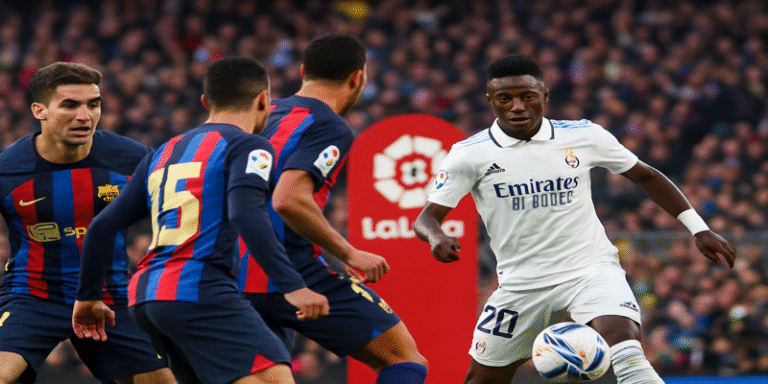La Liga, officially known as the Campeonato Nacional de Liga de Primera División, is the top professional football division of the Spanish football league system. Since its inception in 1929, La Liga has grown into one of the most prestigious and influential football leagues in the world. From the iconic rivalry of El Clásico to its global broadcast reach, the league embodies a unique blend of sporting excellence, cultural identity, and economic power.
Historical Foundations
La Liga was established with just ten teams, including legendary clubs such as Real Madrid, Barcelona, and Athletic Bilbao. Over the decades, the league expanded, survived the Spanish Civil War, and navigated political transitions, evolving into a cornerstone of Spain’s national identity.
The 20th century saw the rise of dynasties: Real Madrid’s dominance in the 1950s and 60s and Barcelona’s golden years under Johan Cruyff and later Pep Guardiola. These eras helped solidify the league’s identity not just within Spain but across the footballing world (Burns, 2012).
The El Clásico Phenomenon
Central to La Liga’s appeal is the historic rivalry between Real Madrid and Barcelona, known as El Clásico. This is more than a football match; it is a symbolic clash representing regional identity, political ideologies, and economic power (Shobe, 2020). Madrid has long symbolised Spanish centralism and monarchy, while Barcelona is often associated with Catalan nationalism and republicanism.
These fixtures attract hundreds of millions of viewers globally and showcase the talents of world-class players—Cristiano Ronaldo, Lionel Messi, Xavi, and Sergio Ramos, among others. The El Clásico brand alone significantly contributes to La Liga’s global marketability and financial strength.
Economic Powerhouse
According to Deloitte (2023), La Liga generated revenues exceeding €3.5 billion in the 2021–22 season. Its economic structure is supported by broadcasting rights, ticket sales, sponsorship, and merchandising. The 2015 centralisation of broadcasting rights marked a turning point, allowing smaller clubs to benefit from more equitable revenue distribution (García & Rodríguez, 2021).
Major clubs like Real Madrid and FC Barcelona remain economic giants. Real Madrid topped Deloitte’s Football Money League several times, indicating the global commercial appeal of La Liga’s biggest names (Deloitte, 2023). However, financial challenges, including mounting debt levels at major clubs, pose long-term sustainability concerns.
Broadcasting and Global Reach
La Liga has strategically expanded its broadcasting and digital media reach to global audiences. Currently, matches are televised in over 180 countries, with key partnerships in Asia, North America, and Africa (LaLiga, 2022). The use of streaming platforms, multi-language commentary, and social media engagement has allowed the league to connect with diverse fanbases.
Unlike the English Premier League, which dominates English-speaking markets, La Liga has found strongholds in Latin America, Francophone Africa, and southern Europe, where Spanish language and cultural proximity offer natural advantages (Lopez-Gonzalez et al., 2022).
Talent Development and Style of Play
La Liga is known for producing and nurturing technical, creative footballers. Its emphasis on possession-based football, tactical intelligence, and youth development has made it a cradle for world-class talent. Academies such as La Masia (Barcelona) and Real Madrid’s Valdebebas have produced stars like Andrés Iniesta, Xavi Hernandez, Iker Casillas, and Raúl.
In recent years, mid-table clubs such as Villarreal, Real Sociedad, and Sevilla have also gained recognition for their structured youth academies and smart recruitment strategies (Pérez-González, 2023). The Spanish Football Federation (RFEF) and La Liga’s development programmes have further promoted grassroots involvement and advanced coaching methodologies.
Cultural Identity and National Unity
La Liga plays a significant role in Spain’s cultural fabric. Football in Spain is deeply regional, with many clubs symbolising local identity. Athletic Club Bilbao, for example, only fields Basque players, a practice that underscores its strong ethnic and cultural heritage. Similarly, Barcelona’s motto—“Més que un club” (“More than a club”)—expresses its deep ties to Catalan pride and resistance.
As noted by Quiroga (2021), La Liga matches often reflect broader political dynamics, with stadiums serving as arenas for symbolic resistance or allegiance. The league becomes a lens through which national unity and fragmentation are expressed.
Challenges: Financial Disparity and Player Exodus
Despite its prestige, La Liga faces several challenges. A growing financial disparity exists between top and bottom-tier clubs, even after revenue centralisation. Additionally, the departures of global superstars like Messi and Ronaldo to other leagues have weakened La Liga’s star appeal in recent years.
Moreover, salary caps enforced by La Liga’s governing body have drawn mixed responses. While they aim to promote financial responsibility, critics argue they may hinder competitiveness in European competitions and restrict clubs’ ability to attract elite players (Rodríguez & Lago-Peñas, 2023).
Digital Innovation and VAR Integration
La Liga has been at the forefront of technological adoption in football. It was one of the early adopters of VAR (Video Assistant Referee), goal-line technology, and biometric player tracking systems. The league also introduced the LaLiga Tech platform, offering advanced data analytics, fan engagement tools, and AI-driven performance insights (LaLiga, 2023).
This technological push has enhanced officiating transparency and added analytical depth for fans, coaches, and broadcasters alike. It also illustrates La Liga’s commitment to modernising its product for a digitally native generation.
Women’s Football and Inclusivity
While La Liga has historically focused on the men’s game, women’s football in Spain is gaining ground. The Primera División Femenina—now branded as Liga F—has become fully professional since 2021. Clubs like FC Barcelona Femení have dominated the UEFA Women’s Champions League, showcasing the league’s growing global reputation.
Public interest is rising; the Camp Nou hosted over 90,000 spectators for a women’s Champions League match in 2022, setting a world record for women’s football attendance (FIFA, 2022). La Liga is now taking steps to promote gender equity, improve facilities, and provide equal media coverage for women’s teams.
La Liga is far more than just a football league—it is a powerful symbol of Spanish identity, a theatre for historic rivalries, and a hub of footballing artistry. Its evolution reflects broader socio-political and economic trends, from Francoist Spain to modern global capitalism. As it navigates the complexities of a globalised sport industry—digital disruption, economic inequality, and changing fan expectations—La Liga remains one of the most compelling stories in world sport.
Its future lies not only in retaining commercial appeal but in preserving the soul of Spanish football—the skill, flair, and passion that have made La Liga a footballing treasure.
References
Burns, J. (2012). La Roja: A Journey Through Spanish Football. Simon & Schuster.
Deloitte (2023). Football Money League 2023. https://www2.deloitte.com/uk/en/pages/sports/articles/football-money-league.html
FIFA (2022). Women’s Champions League Breaks Attendance Record. https://www.fifa.com
García, J. & Rodríguez, P. (2021). “Revenue Sharing and Competitive Balance in the Spanish Football League.” Journal of Sports Economics, 22(2), 109–132.
LaLiga (2022). LaLiga Global Strategy Report. https://www.laliga.com
LaLiga (2023). Innovation and Tech Division: LaLiga Tech. https://www.laligatech.com
Lopez-Gonzalez, H. et al. (2022). “Internationalisation of Football Leagues: A Comparative Study of La Liga and the EPL.” European Sport Management Quarterly, 22(3), 457–475.
Pérez-González, B. (2023). Youth Development and Talent Pathways in Spanish Football. University of Salamanca Press.
Quiroga, A. (2021). Football and National Identities in Spain: The Politics of Passion. Palgrave Macmillan.
Rodríguez, P. & Lago-Peñas, C. (2023). “Financial Fair Play, Salary Caps, and Player Markets in La Liga.” European Journal of Sport Economics, 19(4), 211–232.
Shobe, H. (2020). “El Clásico and the Politics of Football in Spain.” International Review for the Sociology of Sport, 55(1), 33–50.









